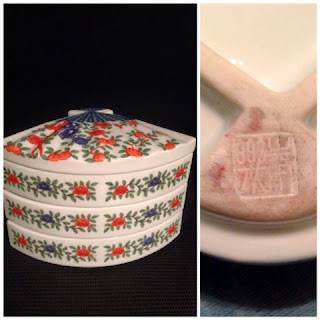In love all the styles and colors of the Jubako stackable ceramic dishes. They traditionally are used for the New Years celebrations. In the days preceding the new year people bustle about cleaning and decorating their homes. Many special foods are prepared beforehand for the three day celebration so that families and friends can enjoy the holiday without having to spend all the time in the kitchen preparing food. They beautifully arrange the food in the jubako. Since Japanese houses are not centrally heated the food is left out in the jubako so that people can just eat when they want. I think they look beautiful set in grouping for display. They would also be a lovely way to arrange finger foods at your next party!
This is sold by Tachikichi, with Tachibana MARK
Fan-shaped Jubako. I am still working on identifying this mark.
This is sold by Dai Ichi Toki (第弌陶器 ) This is the "red" MARK. They have many other marks under their label.
I believe this reads Daigo (醍醐)
This is Arita Yaki with Shosen MARK
This is Mino ware with the Daikichi MARK
Marunishi Tosai MARK (needs verification)














Dai Ichi Toki (第一陶器 ) is not the manufacturer. They are a buyer/importer based in Tajimi, Gifu Prefecture. They purchase wares from the various kilns around Japan, then export them to the US & Europe, etc.. Most notably to Takahashi, San Francisco.
ReplyDeleteIt's very unlikely the piece was made in Tajimi, Gifu since Dai-Ichi Toki is not the manufacturer.
Thank you for your information. I thought they might be like Tachikichi of Kyoto with wares from many kilns, but assumed they also did manufacturing. It may not have been produced in Tajimi, but that area does produce the largest amount of tableware in Japan. That mark seems to be on Kutani/Imari styled pieces so it may have been produced in Ishikawa Prefecture or in Saga Prefecture. Do you happen to know what the lower right kanji reads?
ReplyDelete